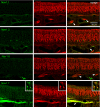Nav1.7 is the predominant sodium channel in rodent olfactory sensory neurons
- PMID: 21569247
- PMCID: PMC3101130
- DOI: 10.1186/1744-8069-7-32
Nav1.7 is the predominant sodium channel in rodent olfactory sensory neurons
Abstract
Background: Voltage-gated sodium channel Nav1.7 is preferentially expressed in dorsal root ganglion (DRG) and sympathetic neurons within the peripheral nervous system. Homozygous or compound heterozygous loss-of-function mutations in SCN9A, the gene which encodes Nav1.7, cause congenital insensitivity to pain (CIP) accompanied by anosmia. Global knock-out of Nav1.7 in mice is neonatal lethal reportedly from starvation, suggesting anosmia. These findings led us to hypothesize that Nav1.7 is the main sodium channel in the peripheral olfactory sensory neurons (OSN, also known as olfactory receptor neurons).
Methods: We used multiplex PCR-restriction enzyme polymorphism, in situ hybridization and immunohistochemistry to determine the identity of sodium channels in rodent OSNs.
Results: We show here that Nav1.7 is the predominant sodium channel transcript, with low abundance of other sodium channel transcripts, in olfactory epithelium from rat and mouse. Our in situ hybridization data show that Nav1.7 transcripts are present in rat OSNs. Immunostaining of Nav1.7 and Nav1.6 channels in rat shows a complementary accumulation pattern with Nav1.7 in peripheral presynaptic OSN axons, and Nav1.6 primarily in postsynaptic cells and their dendrites in the glomeruli of the olfactory bulb within the central nervous system.
Conclusions: Our data show that Nav1.7 is the dominant sodium channel in rat and mouse OSN, and may explain anosmia in Nav1.7 null mouse and patients with Nav1.7-related CIP.
Figures









References
-
- Firestein S. How the olfactory system makes sense of scents. Nature. 2001;413(6852):211–218. - PubMed
-
- Kaupp UB. Olfactory signalling in vertebrates and insects: differences and commonalities. Nat Rev Neurosci. 2010;11(3):188–200. - PubMed
-
- Dib-Hajj SD, Cummins TR, Black JA, Waxman SG. Sodium Channels in Normal and Pathological Pain. Annu Rev Neurosci. 2010;33:325–347. - PubMed
Publication types
MeSH terms
Substances
LinkOut - more resources
Full Text Sources

